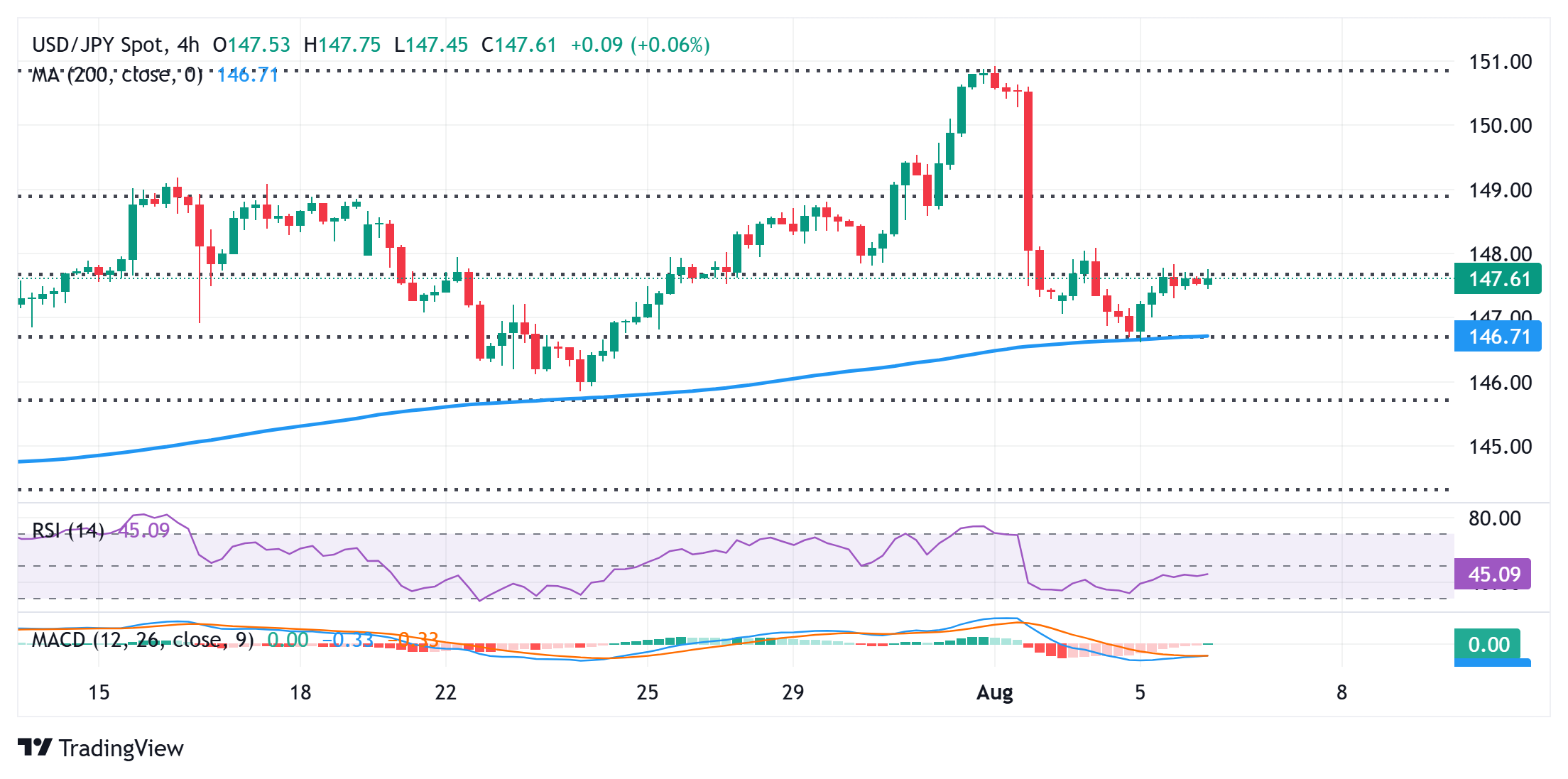The Japanese Yen remains on the back foot after weak real wages data from Japan.Mixed BoJ rate hike cues and signs of stability in equity markets undermine the JPY.Rising September Fed rate cut bets might keep a lid on the USD and the USD/JPY pair.
The Japanese Yen (JPY) oscillates in a range against its American counterpart during the Asian session on Wednesday and moves little following the release of unimpressive macro data. Inflation-adjusted real wages in Japan fell for the sixth straight month in June and fueled concerns about a consumption-led recovery. This comes on top of domestic political uncertainty and tempers bets for an immediate rate hike by the Bank of Japan (BoJ). Adding to this, signs of stability in the equity markets act as a headwind for the safe-haven JPY.
Meanwhile, the BoJ revised its inflation forecast at the end of the July meeting and left the door open for further interest rate hikes by the end of this year. This might hold back the JPY bears from placing aggressive bets. The US Dollar (USD), on the other hand, might struggle to attract any meaningful buyers amid expectations for rate cuts by the Federal Reserve (Fed), bolstered by the disappointing release of the US ISM Services PMI on Tuesday. This, in turn, should keep a lid on the USD/JPY pair’s overnight bounce from a two-week low.
Japanese Yen struggles to lure buyers as softer wage data tempers bets for an immediate BoJ rate hikeGovernment data released earlier this Wednesday showed that nominal wages in Japan rose 2.5% YoY in June, the fastest pace in four months, though it was below market expectations. Adding to this, inflation-adjusted real wages declined 1.3% from a year earlier, following a revised 2.6% drop in May.Meanwhile, the consumer inflation rate the ministry uses to calculate real wages – which includes fresh food prices but not rent costs – rose 3.8% YoY in June, the lowest in seven months. Wage trend and inflation are among the key factors the Bank of Japan monitors to determine the timing of the next rate hike.The data, however, highlights broader pressures on consumption. Furthermore, the ruling Liberal Democratic Party’s loss in the July 20 polls raised concerns about Japan’s fiscal health amid opposition calls to boost spending and cut taxes. This suggests that prospects for BoJ rate hikes could be delayed further. Moreover, BoJ Governor Kazuo Ueda last week signaled continued policy patience. That said, the BoJ has repeatedly said that it will hike interest rates further if growth and inflation continue to advance in line with its estimates. The mixed cues, in turn, do little to provide any impetus to the Japanese Yen.The US Dollar attracts some buyers following the previous day’s two-way price moves and acts as a tailwind for the USD/JPY pair during the Asian session on Wednesday. The USD bulls, however, lack conviction amid the growing acceptance that the Federal Reserve will cut interest rates in September.The bets were reaffirmed by the disappointing US release of the US ISM PMI, which unexpectedly fell to 50.1 in July from 50.8 in the previous month. This comes on top of weaker-than-expected US Nonfarm Payrolls last Friday and fueled worries about the economic health, which could cap the USD. Separately, the US Census Bureau and Bureau of Economic Analysis reported that the trade deficit narrowed more than expected, to $60.2 billion in June from $71.7 billion in the previous month. This reflects a dip in imports at the end of the second quarter following a tariff-fueled spike earlier in the year.In the absence of any relevant market-moving US macro data, speeches from FOMC members could influence the USD later during the North American session on Wednesday. Apart from this, the broader risk sentiment will drive the safe-haven JPY and provide some impetus to the USD/JPY pair. USD/JPY needs to surpass the 148.00 handle to back the case for any further appreciating move
The overnight resilience below the 50% retracement level of the rally from the July swing low and the subsequent recovery favors the USD/JPY bulls. Moreover, oscillators on the daily chart have again started gaining positive traction and back the case for additional gains. That said, any further move up beyond the 147.75 area, or the 38.2% Fibonacci retracement level, might confront some hurdle near the 148.00 round figure. A sustained move beyond the latter will suggest that spot prices have formed a near-term bottom and pave the way for further strength towards the 148.45-148.50 intermediate hurdle en route to the 149.00 neighborhood, or the 23.6% Fibo. retracement level.
On the flip side, the Asian session low, around the 147.45 region, now seems to act as an immediate support for the USD/JPY pair. Any further downfall could be seen as a buying opportunity near the 147.00 round figure. However, some follow-through selling below the 50% retracement level, around the 146.85 area, which coincides with the 200-period Simple Moving Average (SMA) on the 4-hour chart, could make spot prices vulnerable to accelerate the fall towards the 146.00 round figure. The downward trajectory could extend further and eventually drag spot prices to the 61.8% Fibo. retracement level, around the 145.85 area, en route to the 145.00 psychological mark.
Economic Indicator
Labor Cash Earnings (YoY)
This indicator, released by the Ministry of Health, Labor and Welfare, shows the average income, before taxes, per regular employee. It includes overtime pay and bonuses but it doesn’t take into account earnings from holding financial assets nor capital gains. Higher income puts upward pressures on consumption, and is inflationary for the Japanese economy. Generally, a higher-than-expected reading is bullish for the Japanese Yen (JPY), while a below-the-market consensus result is bearish.
Read more.


AloJapan.com